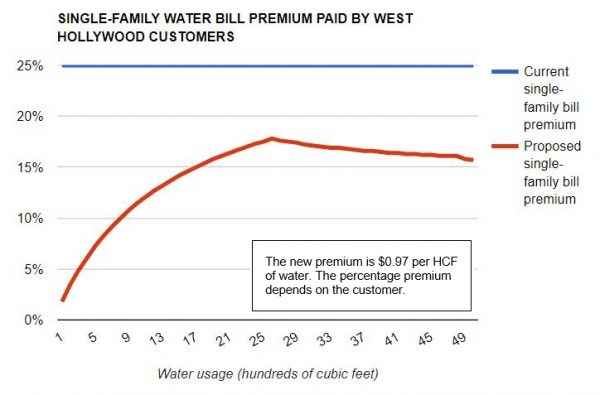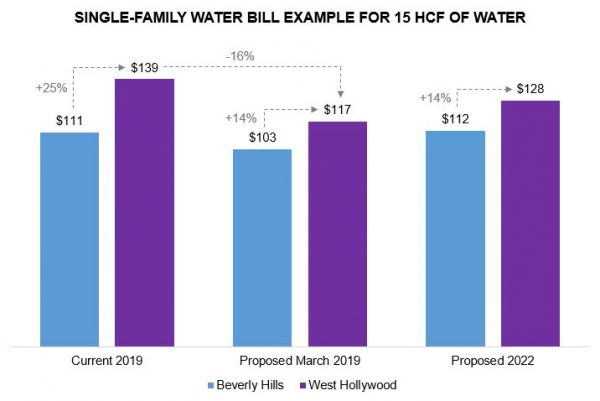West Hollywood residents will continue to pay higher rates than Beverly Hills customers for water from Beverly Hills, but the premium will be smaller under changes being considered by the Beverly Hills City Council on Tuesday. That is according to a new report by WeHo by the Numbers based on city documents.

Beverly Hills provides water to customers on the western side of West Hollywood. The city is proposing changes to their water rates that will redistribute the rate burden among customer classes, service areas (Beverly Hills versus West Hollywood), services, and levels of water use.
Beverly Hills currently charges West Hollywood customers a 25% premium on each part of the water bill. Under the changes, Beverly Hills will instead charge an extra $0.97 per hundred cubic feet (HCF) of water. The report estimates that the effective premium for the whole bill will be somewhere around 15% for many West Hollywood single-family customers. For example, the estimates are 14% for 15 HCF of water usage, 17% for 30 HCF, and 16% for 48 HCF. The report suggests that the percentage premium for many West Hollywood multi-family customers will also be in the teens.
The two cities disagree about whether the premium has been fully justified. The justification is important because California’s constitution limits water rates to the actual cost of service. The justification could be based on either (1) West Hollywood customers costing more to serve (not the case) or (2) Beverly Hills indirectly subsidizing water rates for Beverly Hills customers by using taxpayer money for water-related costs.
Beverly Hills’ consultant estimated water-related costs borne by Beverly Hills taxpayers and then calculated the share that will be recovered from water customers in West Hollywood. They looked at costs related to street maintenance ($0.45 per West Hollywood HCF), public safety ($0.25), water infrastructure ($0.15) and office space ($0.12). The estimates are subject to debate. West Hollywood has publicly raised questions about several aspects of the consultant’s study, as did an earlier WeHo by the Numbers analysis.
The proposed rates deviate from the consultant’s recommendations in one way that reduces the size of the West Hollywood premium. Two properties owned by the water enterprise have been leased out. The consultant recommended crediting that revenue only to Beverly Hills customers. The city decided instead to share the benefit among all customers.

Given all the rate changes, the report looked at the net effect on bills for West Hollywood residential customers. For many single-family customers, the rate changes may result in smaller bills. That is due to the reduced West Hollywood premium combined with changes that benefit the low-to-moderate usage levels common among West Hollywood residents.
For example, a West Hollywood single-family home that uses 15 HCF could see its bill shrink by an estimated 16% or $22. It would still be 14% higher than a similar house in Beverly Hills, but it would be lower than today’s 25% premium. The bill would edge up each year due to across-the-board rate increases. By 2022, the West Hollywood premium would still be 14% and the total would remain below the current bill. That answer is different for customers using more water.
The estimates assume that water-shortage-related rate increases — called “revenue stabilization factors” – will not be in effect. For example, if the city council declared a Stage D water shortage, single-family customers would be required to cut their water use by 36% and the per-unit water charge would increase 33%. Multi-family customers, who use less water for irrigation, would be required to cut 16% and would face an 11% rate increase.
The overall impact of the rate changes on West Hollywood multi-family bills is likely to be mixed. The West Hollywood premium is shrinking at the same time that the multi-family rate burden is generally increasing. A four-unit apartment building that uses 10 HCF per unit could see a bill increase of 7% or $21, even with its West Hollywood premium shrinking from 25% to 13%.
One issue raised in the new report is the higher water charges paid by many multi-family households compared to single-family households using the same amount of water. The differential is surprising, because multi-family water demand is less variable and, therefore, less costly to serve.
To find out more, see the full report, How will proposed changes in water rates affect West Hollywood customers?

Great reporting — thank you for digging deep and crunching the numbers.